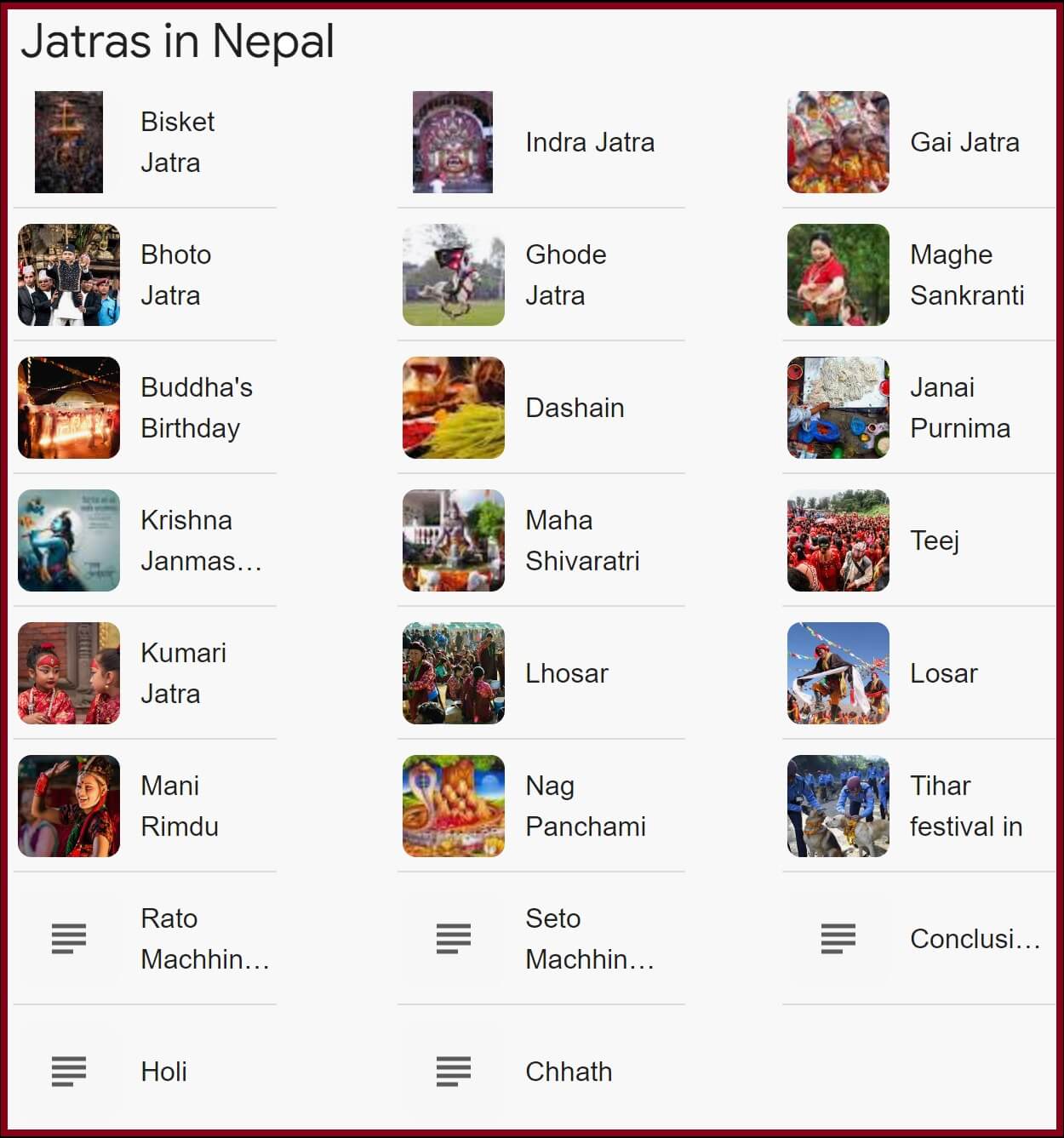
All Jatras in Nepal: A Complete Guide to Nepal’s Traditional Festivals and Celebrations
A jatra is a community festival rooted in processions, public rituals, music, masked dance, and shared food. In the Kathmandu Valley and across Nepal, jatras knit faith, memory, and neighborhood life.
Some mark the change of seasons; others help families remember loved ones, clean shared water sources, or carry a living goddess through the old city. Dates shift each year with the lunar calendar, so travelers and students should check official festival listings for current schedules.
From an educational psychology lens, these gatherings strengthen belonging, reduce stress through predictable ritual, and turn individual grief or hardship into shared support—something you’ll feel at Gai Jatra or during all-night vigils at Bala Chaturdashi. The water-cleaning work at Sithi Nakha shows how ritual guides community action for public health.
Table of Content
- All Jatras in Nepal: A Complete Guide to Nepal’s Traditional Festivals and Celebrations
- How to use this guide
- A quick calendar snapshot
- Seven must-see jatras of the Kathmandu Valley
- Beyond the Valley: jatras and festival days across Nepal
- Etiquette, accessibility, and safety
- Learning outcomes: what festivals teach us
- Festival field guide (by theme)
- Real-life snapshots
- Practical planning for you, your students, and your team
- Glossary (quick reference)
- Why these festivals endure
- Conclusion
- FAQs
How to use this guide
-
If you’re a first-time visitor, start with the “Seven must-see jatras of the Valley.”
-
If you’re planning your research or reporting, use the “Field notes” under each festival for logistics, etiquette, and safety.
-
If you’re a learner or educator, scan the “Meaning” lines to connect each festival to culture, identity, and wellbeing.
A quick calendar snapshot
Dates vary year to year. Here are typical windows (check exact dates each year):
-
Seto Machhindranath Jatra – March/April (3 days in central Kathmandu).
-
Ghode Jatra – late March or early April at Tundikhel.
-
Rato Machhindranath Jatra & Bhoto Jatra – late April to June in Lalitpur.
-
Sithi Nakha – May/June (water-source cleaning day in the Valley).
-
Buddha Jayanti – April/May (nationwide; major events at Lumbini).
-
Janai Purnima & Gosaikunda Pilgrimage – August (Langtang).
-
Gai Jatra – August (Kathmandu, Bhaktapur, Lalitpur).
-
Indra Jatra (Yenya) – August/September in Kathmandu.
-
Mha Puja & Nepal Sambat New Year – during Tihar (October/November).
-
Chhath – October/November (strongest in Janakpurdham).
Seven must-see jatras of the Kathmandu Valley
Indra Jatra (Yenya) — the living goddess, chariots, and masked dance
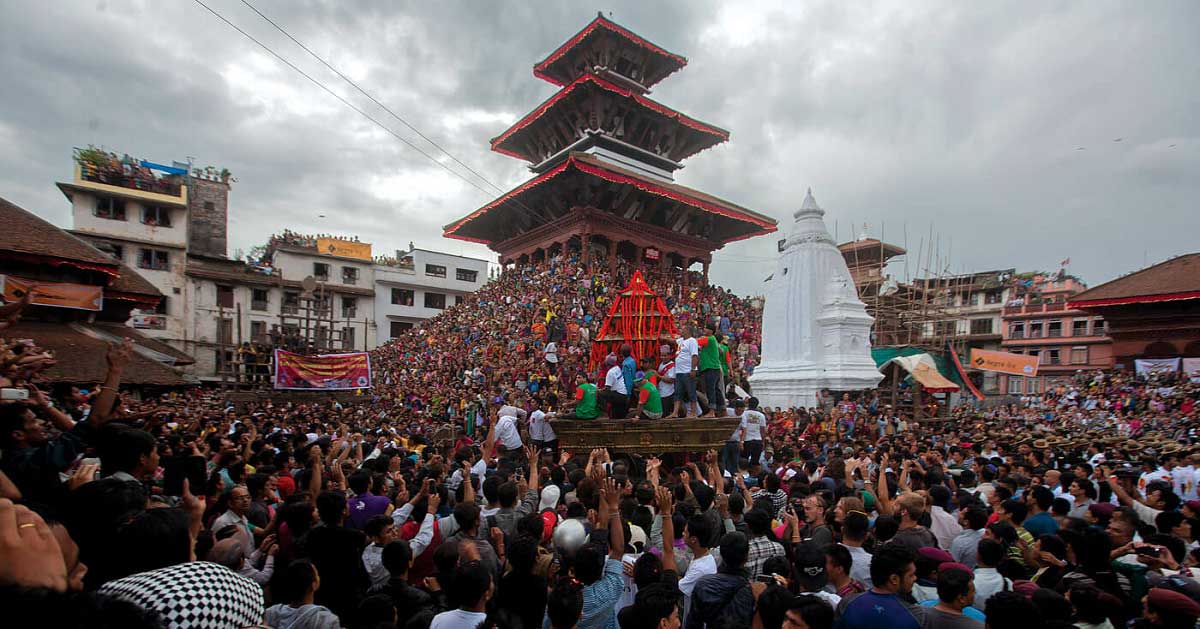
Where: Historic core of Kathmandu: Basantapur (Hanuman Dhoka), Kilagal, Indrachok, and surrounding lanes.
What you’ll see: The Kumari (living goddess) rides a chariot through the old city, with chariots of Ganesh and Bhairav. Lakhey and Pulukisi masked dances animate courtyards. Officials and large crowds fill Durbar Square.
Meaning: A Newar celebration of the autumn harvest cycle, city protection, and renewal of social bonds through processions and dance.
Field notes: Arrive early near Hanuman Dhoka for a safe view. Dress modestly, step aside for chariots, and keep children close in dense lanes.
Rato Machhindranath Jatra — Nepal’s longest chariot procession
Where: Lalitpur (Patan): chariot built at Pulchowk, then pulled across city neighborhoods to Jawalakhel for Bhoto Jatra.
What you’ll see: A towering chariot bearing Bunga Dyah (Rato Machhindranath, the Red Karunamaya) moves over weeks; Bhoto Jatra climaxes with a jeweled vest held aloft.
Meaning: Prayers for rain, compassion, and wellbeing shared by Buddhist and Hindu devotees.
Field notes: Wooden wheels and ropes can swing—the safest vantage is from raised steps set back from junctions. Carry water and a hat in late spring heat.
Seto Machhindranath (Janabaha Dyah) — three days through the old bazaar
Where: Central Kathmandu: Jamal, Ason, Indrachok, Hanuman Dhoka, and Lagan.
What you’ll see: A white-faced Karunamaya on a chariot, rifle salutes by soldiers at daily halts, and a ritual bathing and repainting of the image.
Meaning: Compassion, renewal, and protection for the city’s trading quarters.
Field notes: Narrow streets get tight around Ason. Step into shop thresholds to let the chariot pass.
Gai Jatra — remembrance with humor and satire
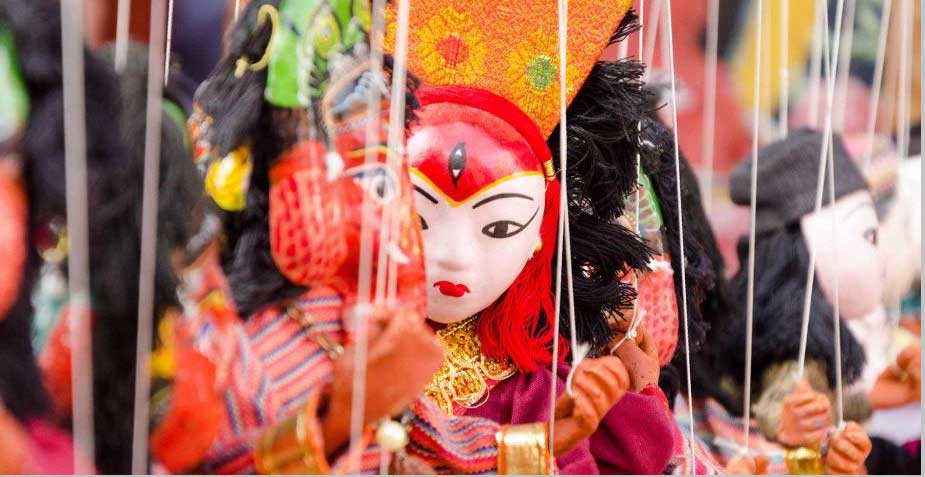
Where: Core areas of Kathmandu, Bhaktapur, and Lalitpur.
What you’ll see: Families who have lost loved ones in the past year join processions, often with a child dressed as a cow; satirical performances lighten grief. The LGBTQ+ community marks Pride during Gai Jatra in Kathmandu.
Meaning: Public grief becomes shared strength; humor and parody help families carry loss.
Field notes: Ask before photographing mourning families. Step off the route to give space to children in costume.
Ghode Jatra — cavalry feats at Tundikhel
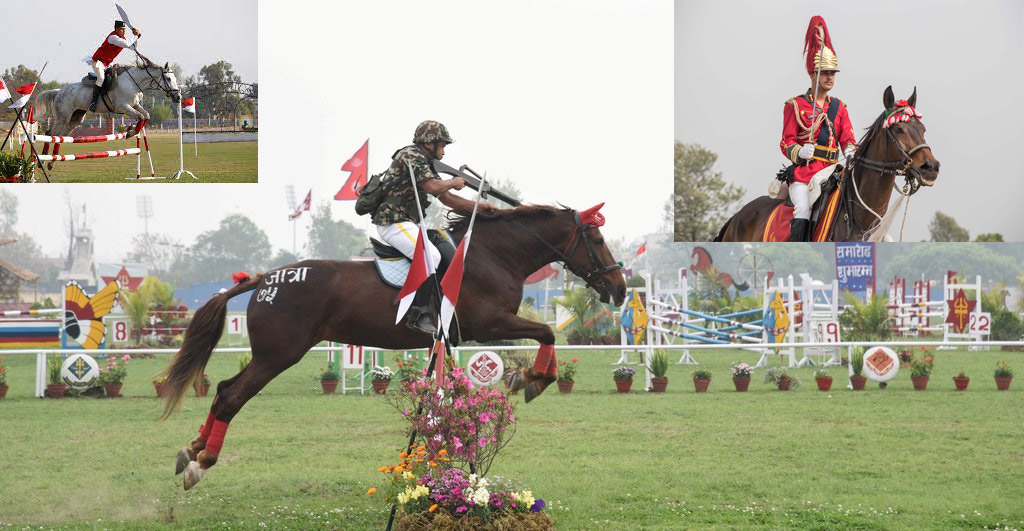
Where: Tundikhel parade ground, Kathmandu.
What you’ll see: The Nepal Army’s horse parade, riding displays, and sky-drops in the presence of national leaders. Crowds gather along the ground’s edge and nearby rooftops.
Meaning: Riders circle the field to “keep the demon Tundi down,” a story many locals share about this annual display.
Field notes: Gates open well before the show. Pack ear protection for children; sudden bursts can startle them.
Sithi Nakha — cleaning the Valley’s water sources
Where: Across Kathmandu, Lalitpur, and Bhaktapur.
What you’ll see: Neighbors cleaning stone spouts (hiti), wells, and ponds to prep for monsoon; youth pull silt, clear drains, and repaint shrines.
Meaning: An ecological rite with deep roots—maintaining shared water points supports household health. Local water studies point to seasonal stress and the value of community care.
Field notes: Dress for mud, carry gloves, and ask how you can help without getting in the way.
Bala Chaturdashi — night vigil and morning Satbij
Where: Pashupatinath area and Sleshmantak forest; at Shiva shrines nationwide.
What you’ll see: Families keep all-night lamps, then scatter satbij (seven seeds) at dawn while circling sacred sites to honor the departed.
Meaning: A tender ritual of memory and release that draws thousands to Pashupati each year.
Field notes: Be gentle with cameras during the vigil. Follow the marked path and avoid blocking narrow stairs or shrines.
Beyond the Valley: jatras and festival days across Nepal
Bisket Jatra (Bhaktapur & Thimi)
A New Year pull of massive wooden chariots and a community tug-of-war over ropes that can strain streets and crowds. In nearby Thimi, Sindoor Jatra throws clouds of vermilion as dozens of small chariots wheel through town; at Bode, one devotee undergoes a tongue-piercing rite under community supervision. Watch from a doorway or balcony and avoid standing between ropes and wheels.
Shikali Jatra (Khokana, Lalitpur)
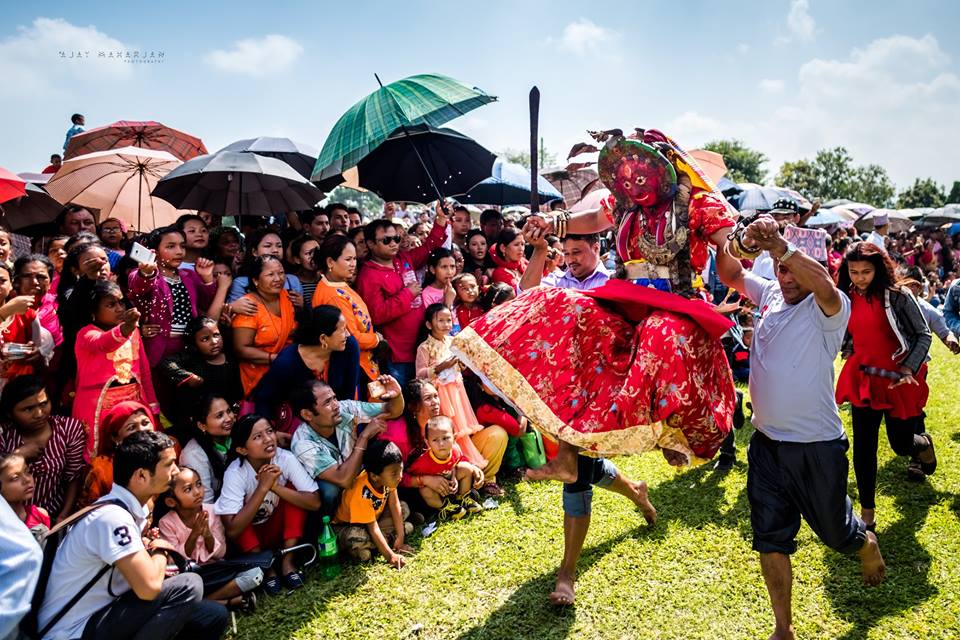
Masks, deities, and field rituals in a farming town south of Patan. It’s intimate and community-led; treat sacred spaces with care and avoid drones over crowds.
Janai Purnima at Gosaikunda (Rasuwa)
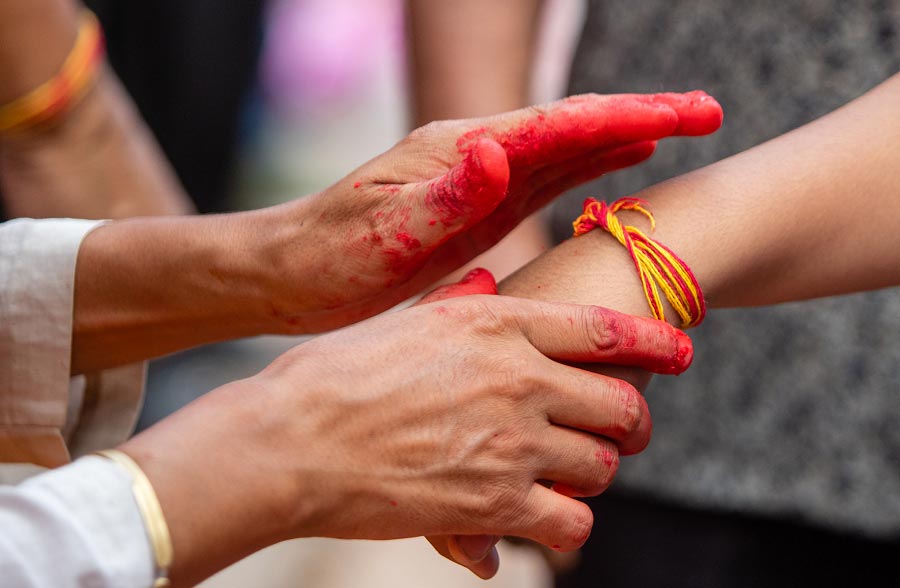
Pilgrims trek to the alpine lake of Gosaikunda (4,380 m) for a holy dip and sacred-thread renewal. If you hike, plan for altitude and cold nights; this is not a casual day trip.
Buddha Jayanti (Lumbini and major stupas)
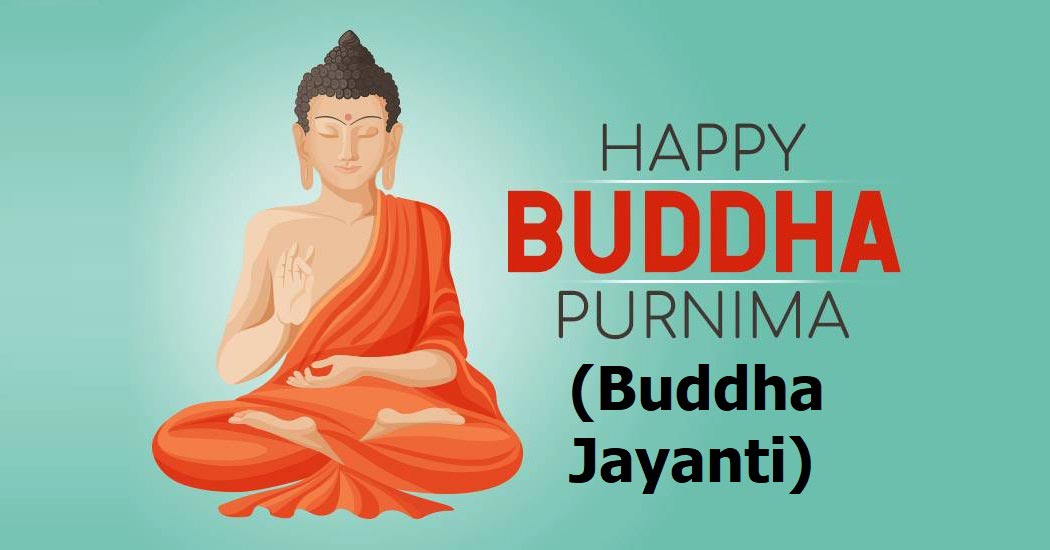
Ceremonies at Lumbini, Swayambhu, and Boudha honor the birth, awakening, and passing of the Buddha with peace walks, lights, and recitations.
Haritalika Teej (Pashupatinath and Shiva temples)
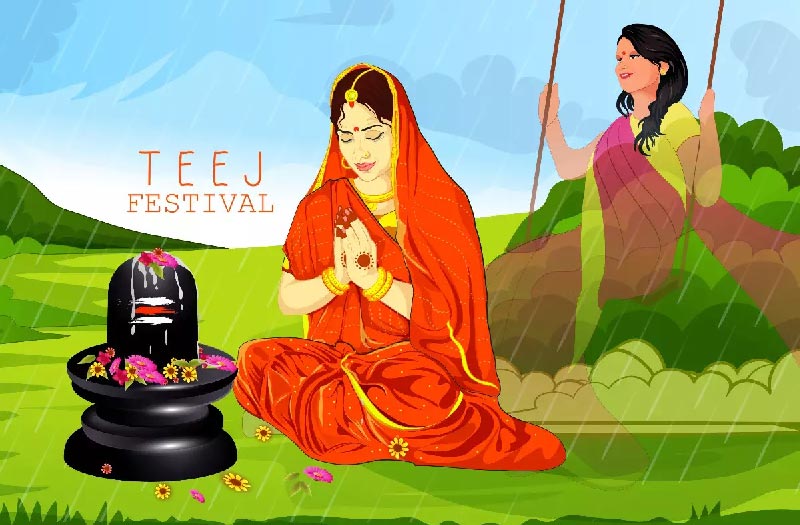
Women gather at Pashupatinath in red dress, sing, fast, and offer prayers. Local authorities use multiple entry routes and early openings to spread the crowd; follow posted guidance and respect queue lines.
Chhath (Janakpurdham and riverbanks nationwide)
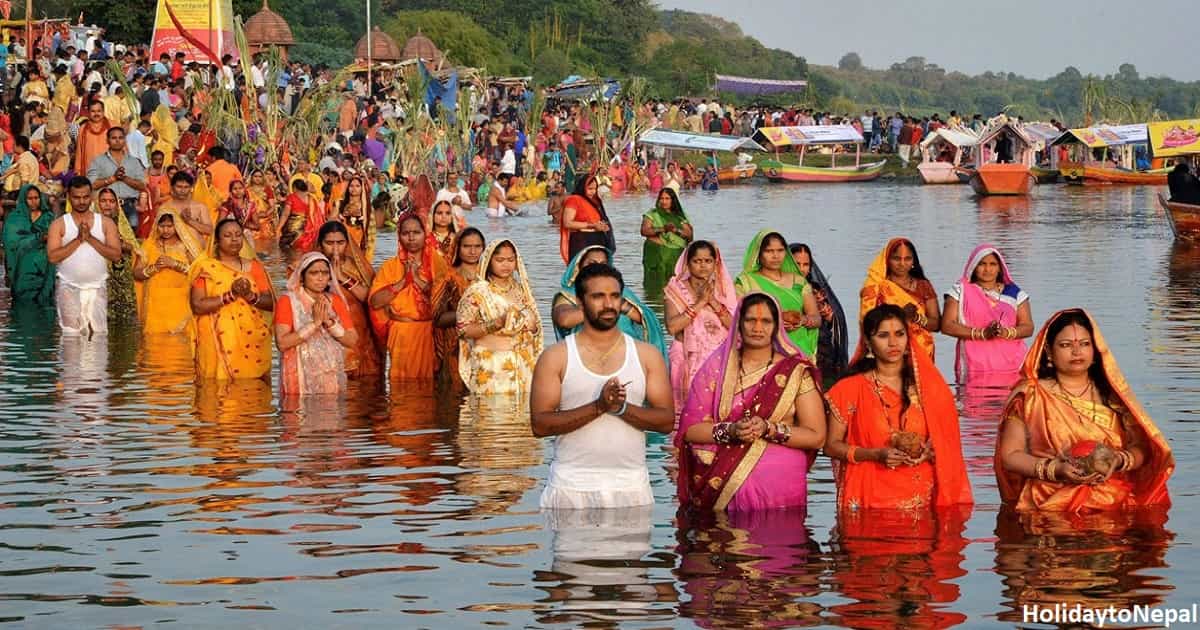
A four-day sun-worship festival led by women in the plains. In Janakpur, devotees pray at ponds and river ghats at sunset and sunrise. If you visit, keep ghats clear during arati and avoid flash photography.
Losar family of New Year festivals (Tamu/Gurung, Tamang, Sherpa)
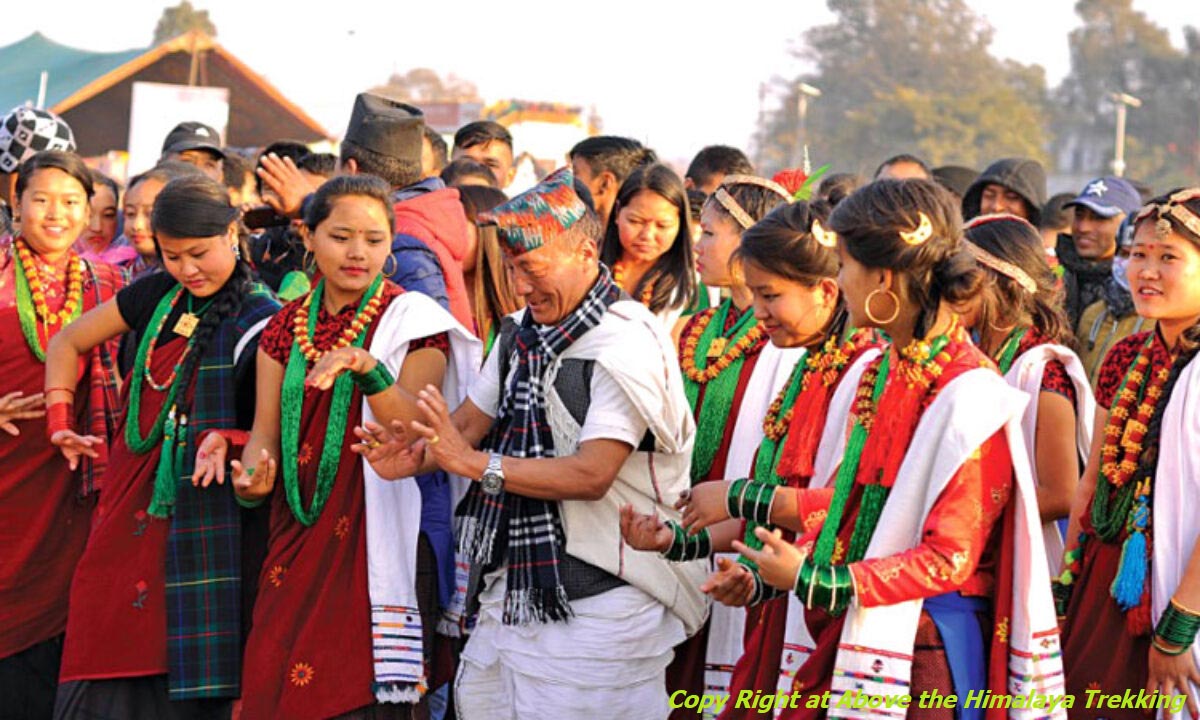
Lhosar marks New Year across Himalayan communities. Dates differ by tradition: Tamu Lhosar in December/January; Sonam (Tamang) around January/February; Gyalpo (Sherpa) around February/March. Public dances and gatherings take place at Tundikhel or monasteries.
Mha Puja and Nepal Sambat New Year (Newar households)
Families draw mandalas on the floor and honor the body and the self; the same day marks the Newar New Year. You may see processions and greetings across the Valley during Tihar.
Etiquette, accessibility, and safety
1) Respect sacred space
Give right of way to chariots and palanquins. Ask before photographing mourning families at Gai Jatra or Bala Chaturdashi.
2) Crowd sense
At Tundikhel on Ghode Jatra, remain behind barriers and protect hearing for children. During rope pulls at Bisket Jatra, never stand between the ropes, wheels, or stone plinths.
3) Environment and health
Join Sithi Nakha clean-ups with local consent; these actions help keep hitis usable as the rains begin. For Gosaikunda, 4,380 m is high altitude; acclimatize and consult a clinician if you have concerns.
4) Access tips
Many events are free and outdoors. For elders or young children, pick a side street with a clean view rather than the densest square. During Teej and Chhath, ghats and temple inner queues can be intense; plan early morning or off-peak visits, follow route signs, and carry water.
Learning outcomes: what festivals teach us
Collective memory
Gai Jatra and Bala Chaturdashi give families a structured way to grieve and remember together.
Civic care
Sithi Nakha ties faith to maintenance of public water, linking ritual to health.
Place attachment
Chariot routes—Seto and Rato Machhindranath—move through the city like living maps, reinforcing neighborhood identity.
National display
Ghode Jatra blends legend with a formal Army show, signaling unity and skill.
Intercultural rhythm
Losar, Teej, and Chhath reflect Nepal’s language families and regions while inviting neighbors to watch or join respectfully.
Festival field guide (by theme)
Processions and chariots
-
Indra Jatra: Three chariots (Kumari, Bhairav, Ganesh); masked dances; night displays.
-
Seto Machhindranath: Three-day city loop with rifle salutes.
-
Rato Machhindranath: Weeks-long pull through Lalitpur; Bhoto Jatra finale.
Water-related rites
-
Sithi Nakha: Cleaning wells, spouts, and ponds before monsoon.
-
Gosaikunda on Janai Purnima: Pilgrimage to an alpine lake at 4,380 m.
Women-led worship
-
Haritalika Teej: Fasting, singing, and darshan at Shiva temples; large queues at Pashupati with route management updates each year.
-
Chhath: Four-day rites to the Sun at water bodies; peak moments at sunrise and sunset.
New Year cycles
-
Losar family: Gurung (Tamu), Tamang (Sonam), Sherpa (Gyalpo).
-
Nepal Sambat & Mha Puja: Household self-worship and Newar New Year during Tihar.
Real-life snapshots
A father in Bhaktapur points out rope burn marks on a stone plinth—“Stand here and you’ll get knocked,” he says with a grin—then guides two teens to a safer stoop. This is how festival knowledge passes on.
On Gai Jatra, a mother hands a photo of her son to a volunteer who helps place it beside a child dressed as a cow. A drummer starts a light rhythm and the family smiles through tears.
In Patan, neighbors lift buckets from a stone spout on Sithi Nakha, pulling silt so the first monsoon flush will run clean.
Practical planning for you, your students, and your team
Transport
For Valley jatras, walk or use short hops on public transport; many streets close without notice during pulls or processions.
What to pack
Comfortable shoes, a shawl or light jacket, water, and a small pouch for offerings. For Gosaikunda or other high-country worship sites, carry warm layers, rain protection, and basic altitude remedies as advised by your clinician.
Photography & media
Ask before shooting close-ups, especially at mourning events or women-only rituals. Avoid drones over crowds or shrines unless local authorities have granted written permission.
Accessibility
Many squares have steps and uneven brick; choose edges of routes where you can stand with support. During Teej and Chhath, prioritize side ghats and early hours to reduce time in queues.
Glossary (quick reference)
Jatra: Procession-based festival.
Kumari: Living goddess of Kathmandu seen during Indra Jatra.
Hiti/Dhunge dhara: Stone spout; traditional water source cleaned at Sithi Nakha.
Bhoto Jatra: Vest-display rite that closes the Rato Machhindranath procession.
Ghat: Riverbank worship area used during Chhath.
Mha Puja: Self-worship rite and Newar New Year day.
Why these festivals endure
Jatras thrive because they solve real needs: managing grief together, maintaining shared resources, renewing the ties between households and place, and giving young people a role in community life.
They are living classrooms for culture and civic care. The details shift each year, yet the core aims stay steady—remember, clean, bless, and celebrate.
Conclusion
If you plan well and move with respect, Nepal’s jatras will welcome you into courtyards, streets, and lakeshores where faith and neighborhood life meet. Start with one festival that speaks to your interests—perhaps the pageantry of Indra Jatra, the long pull of Rato Machhindranath, the quiet strength of Sithi Nakha, or the sunrise songs of Chhath. Watch, listen, and walk with the crowd; the lesson is in the street.
FAQs
1) Are jatra dates fixed each year?
No. Most follow the lunar calendar and shift each year. Check official event lists or local notices near the date.
2) Can visitors join processions?
You can walk alongside and observe. Do not touch chariot ropes unless invited by locals, and never step in front of a moving wheel.
3) Is photography allowed at sacred moments?
Public squares welcome photos, but ask first at mourning rituals (Gai Jatra) and during all-night vigils (Bala Chaturdashi). Avoid flash at Chhath sunrise or inside temple sanctums.
4) How can students use jatras for learning?
Map a chariot route to study urban history, document Sithi Nakha clean-ups to learn community health, or interview elders about ritual roles. Pair observations with readings on Valley water and public memory.
5) What’s the safest way to watch Ghode Jatra?
Arrive early, stand behind barriers, and keep children close when the cavalry rides past or when parachute displays occur.
Festival Culture

